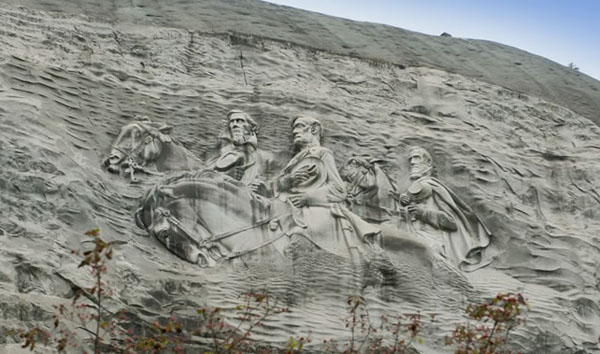The Stoning of Stone Mountain
John Marquardt, The Abbeville Institute, November 11, 2019

Stone Mountain
There are really only two basic opinions when it comes to the world’s largest carving on the face of the fifteen million year old granite monolith just outside Atlanta, Georgia … revere it as an important chapter in American history or destroy it as a shameful altar to the Ku Klux Klan. While there are many Americans with their own personal or political agendas concerning the mammoth monument at Stone Mountain, such as the former minority leader of the Georgia House of Representatives and the unsuccessful candidate for that State’s governor in 2018, Stacy Abrams, who demands that the famed Confederate memorial be sandblasted from the face of the mountain, many others, even foreign visitors, take a far different view of the famed carvings. In March of last year, a lady from Japan named Yumiko Yamamoto, the president of a group called Japanese Women for Peace and Justice, made her first visit to Atlanta and on her tour of Stone Mountain she was greatly impressed by not only the massive equestrian figures of President Jefferson Davis and Generals Robert E. Lee and “Stonewall” Jackson, but also the inscription on the monument’s plaque by Beverly M. DuBose, which reads; “The vast majority of those who fought and died for the Southern Confederacy had little in worldly goods or comforts. Neither victory nor defeat would have greatly altered their lot. Yet, for four long years they waged one of the bloodiest wars in history. They fought for a principle: The right to live life in a chosen manner. This dedication to a cause drove them to achieve: A monument of greatness which endures to this day.” Ms. Yamamoto gave a talk about her experience after she returned to Tokyo the following month and an account of her visit appeared later in the “Shukan N. Y. Seikatsu,” a Japanese newspaper in New York City, in which she was reported as saying; “Although the Confederates lost the Civil War, they praise the courage and honor of those who fought and died for the Confederacy. I thought Japanese should pass down our story just like their words to the next generation. Japan (also) lost the war, but we should honor those who fought and died for our country with the words just like I found at Stone Mountain Park.”
{snip}
The fact that some extremists may choose to use Stone Mountain as a rallying point from time to time, just as such groups misuse the Confederate Battle Flag, is actually irrelevant, and does not detract from the true purpose of the memorial. Some wiser voices have called for compromises that would keep the Confederate memorial intact but add other monuments that the opposition could support, such as reviving the 2015 proposal by the Stone Mountain Memorial Association that a mountaintop bell tower be erected in honor of Dr. Martin Luther King’s 1963 “Dream” speech in which he said; “Let freedom ring from Stone Mountain of Georgia.” One of the leading advocates of such moves is the chief operating officer of DeKalb County in which Stone Mountain is located, Michael Thurmond, who is also the only black member of the Memorial Association. These attempts at a return to sanity, however, continue to be drowned out by the constant drumbeat of anti-Confederate and anti-Southern hatred and propaganda, such as last year’s “Graven Image” documentary from PBS which dwelled mainly on the connection between Stone Mountain and the Klan, as well as attempting to promote the false theory that the monument was created merely as a racist symbol to support so-called “white supremacy.” Those like Stacy Abrams and the NAACP who seek to use this hatred for political gain also continue to cry that the carving is a blight on the State of Georgia and should be removed. With such people, there is no compromise nor any hope of reconciliation when it come to anything connected to the Confederacy, including Stone Mountain.
{snip}
Rather than standing alone as a grand and solemn monument to honor those who fought and died for the Confederacy, the area has today become little more than a theme park with the monument as its dramatic backdrop, a park replete with a train ride, a recreated antebellum village, a giant 3-D theater, a miniature golf course and a large playground filled with dinosaur replicas, as well as serving as the venue for many various demonstrations, including those that urge the removal of the park’s only true identity and purpose. One can now but hope that sometime in the not too distant future some measure of sanity will finally prevail, with politics and prejudice being laid aside and the monument at Stone Mountain regaining its intended place as an important part of American history and heritage. It might be further hoped that the monument would not only continue to serve as a memorial to those who fought and died for their country, but also become one that would fulfill Dr. King’s dream of a mighty symbol for unity and racial reconciliation.
{snip}















